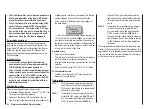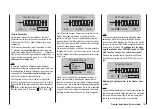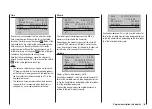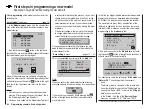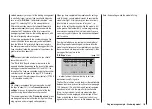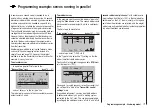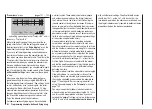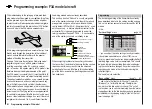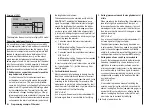
169
Programming example - fixed-wing model
scribed previously, or as part of the braking arrangement
in a butterfly (crow) system, then you should
always
en-
ter a value for “
Diff.-Red.
” (“differential reduction” - see
page 113) - selecting 100% is the safe option here!
Differential reduction means that aileron differential is
suppressed proportionally
only
when you operate the
airbrake stick. The purpose of this is to increase the
down-going aileron travel on the landing approach, with
the aim of improving
aileron response
.
If the wing is equipped with two camber-changing flap
servos in addition to two separately actuated ailerons,
then the “
AIL
FL
” (aileron
flap) mixer transfers
the aileron movements to the flaps; we suggest that the
flaps should not follow the movement of the ailerons to a
greater extent than about 50%.
Note:
If you have only installed one flap servo, you should
leave this mixer at 0%.
The “
FL
AIL
” (flap
aileron) mixer works in the
opposite direction; depending on the layout of the model
we suggest values between about 50% and 100% for
this option. The flaps are controlled using the transmitter
control or switch assigned to the input “E6”. Preferably,
however, one of the rotary proportional controls (CTRL 6
… 8) should be used for this.
Note:
We strongly recommend that you reduce the travel of
the flaps to about 25% in the “
Transmitter control
settings
” menu, as this gives finer control of the flap
positions using the selected transmitter control.
The remaining options in the “
Fixed-wing mixers
” menu
are designed to provide further fine-tuning of multi-flap
wing systems, and are largely self-explanatory.
When you have completed the model-specific settings
up to this point, you are probably ready to consider the
model’s first flight. At this juncture you should certainly
take the time to carry out a series of “dry runs”, i. e.
check all the settings thoroughly while the model is still
on the ground. Remember that a serious programming
error may damage more than just the model. If you are
not sure of any point, please ask an experienced model
pilot for advice.
If during the test phase you realise that one or other of
the settings needs to be changed in order to tailor the
model’s control response to your preferences - perhaps
the servo travels are too great or too small overall - then
we suggest that you turn to the …
“D/R Expo”
menu
122%
100%
111%
+11%
0%
aile
elev
rudd
DUAL EXPO
2
2
–––
+22%
… in order to adjust the overall set-up to suit your
requirements and flying style.
The Dual Rate function is used to adjust the relationship
between stick travel and control surface travel (see page
102). However, if it is only the model’s control response
around neutral which is too powerful for comfortable
flying, i. e. the maximum travels are acceptable, then
“Exponential” can be employed, either instead of Dual
Rates or in addition to them. If a physical switch is as-
signed to this function, you can switch between two Dual
Rate / Expo settings while the model is flying.
Summary of Contents for mx-12 Hott
Page 1: ...Programming Manual 33116 mx 16 HoTT 3 en mx 16...
Page 35: ...35 For your notes...
Page 49: ...49 For your notes...
Page 55: ...55 For your notes...
Page 59: ...59 For your notes...
Page 63: ...63 For your notes...
Page 69: ...69 For your notes...
Page 91: ...91 For your notes...
Page 101: ...101 For your notes...
Page 123: ...123 For your notes...
Page 181: ...181 For your notes...
Page 193: ...193 For your notes...


